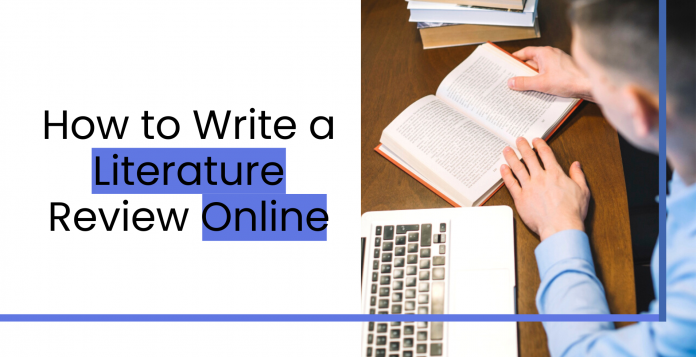How to Write a Literature Review Online
You may be preparing a literature review, but may not be sure from where to start. It’s always better to have an outline, and regardless of what kind of text you’re writing – be it book analysis, a research paper or literature review. In this article, we will explore all the vital elements that make up a flawless literature review and share with you a basic literature review outline to help you get started.
Check out this unique guide to find expert advice on how to write a coherent and well-articulated literature review.
What is a Literature Review?
Several students tend to confuse Literature review with a book review, which is a consumer-driven analysis of a peculiar novel’s worth as well as readability. On the other hand, a literature review is a scholastic survey of a particular field’s system and body of work. If you’ve been tasked to write a literature review as part of your curriculum, or for something else, it’s mandatory for you to understand this crucial difference.
That said, it is also helpful to understand the distinctions that exist between literature reviews and research papers. While research papers play an instrumental role in bringing new ideas to an academic field, using a specific school of thought as a basis for their claims, literature reviews simply assemble old and popular ideas and arguments from different collections with the intent of providing accessibility. They can function as curricula for some fields, and place the author as a tour guide, highlighting the significant texts that best define the selected subject. If you want to aggregate lab research in the field of humanities and sciences, then Literature Reviews can be quite helpful.
The Elements of a Literature Review
You might be concerned about the different parts that make up a decent literature review. Here, we will discuss the numerous elements that one must include in their paper, and followed by that, how can one best assemble it to suit their needs. Literature reviews are often just like simple surveys and analysis of a sector’s body of work. However, they are still required to have a central theme. You may want to highlight a ground-breaking and fresh trend in your chosen field, or perhaps just choose the unifying concept from your collection of literature texts and expound on how and where this concept emerges in the field.
There may also be a particular point where debate is necessary and you may want to focus on that. For instance, let’s assume that you want to discuss the way independent film-makers are beginning to address core women’s issues in their field work, specifically by including more female leads in their films, and making their movies more inclusive or gender-diverse. Your chosen field is game media and film-making, and the theme you plan to address is the present-day introduction of a feminist ideology to this field in particular. In the thesis statement of this literature reviews, we don’t introduce any new information about the field, in fact, you need to have a thesis statement that emphasises to the reader, with clarity, the particular trend, theme, concept, or debate you have decided to address in your Literature Review. Alternatively, you can also access premium UK best assignment writing services available on the internet.
How to Write a Literature Review Outline?
Once you have gained significant clarity on the theme you want to write about, have formulated a smart thesis statement, and a relevant collection of work to cite, it is finally time to begin with outlining your paper.
I – Introduction
a. Summarise the topic: This is the part where you write a brief overview of the field that you have chosen and give a clear introduction of the theme you have decided to expound upon within that field. Keeping in line with our example, you can discuss the film industry’s traditionalist approach and general lack of strong female leads, and the manner in which their male counterparts are paid more than the female ones.
b. Thesis statement: In this part, you will devise your thesis statement, and combine your summary of the subject and present the theme you are going to analyse. You need to utilise this part to identify the possibility of a revolutionary point for the film industry, and how certain indie film-makers are working to challenge the orthodox status quo.
II – First Theme
This is the part you provide an outline of your first theme, highlight the way it has risen up in your chosen subject, and identify relevant texts to be used as reference material. Let’s assume that you decide to discuss the slow but steadily growing inclusion of female characters in films over the last few decades.
a. Sub-theme: It is important that you break your main theme up into different parts, that way you can make it easily understandable. That is basically the whole the point of this. In this part, you are required to discuss an aspect of your theme, and ponder upon how that particular part allows us to make up the whole. As staying with our aforementioned example, we could discuss the numerous ways film-makers have decided to simply include female lead characters in addition to their male counterparts, and provide references of the appropriate texts that have analysed this trend.
b. Sub-theme. You must also continue to cite different aspects of your main theme or idea. This is the part where you can discuss the different ways film-makers have chosen to give female lead characters a chance with a practical approach, giving them their basic right to equality as well as equal pay. You could cite relevant film-making logs, movies, articles, and news related to this topic.
c. Sub-theme. Try to have as many body paragraphs as possible to discuss and emphasise the point you are trying to make.
III – Conclusion
For a literature review, you should consider writing a conclusion that is a couple of paragraphs long, where you are able to summarise your discussion. Make sure you cover all the discussed points of the body within your conclusion. Do not repeat ideas as that would confuse the readers. Also, there has to be a consistency and uniformity in between your content ideas for the body as well as conclusion. So, the writer must ensure to form a precise, meaningful and thoughtful conclusion for the readers.
Final Thoughts
Students requiring dissertation help usually thumb through the internet for the process of Literature review. Also, there are several students who aren’t taught the method to form a well-structured and articulated literature review in their classes, they may also take help from this guide.
As a student, you must ensure to follow each of the steps religiously to write a coherent literature review for your dissertation. Good luck!



